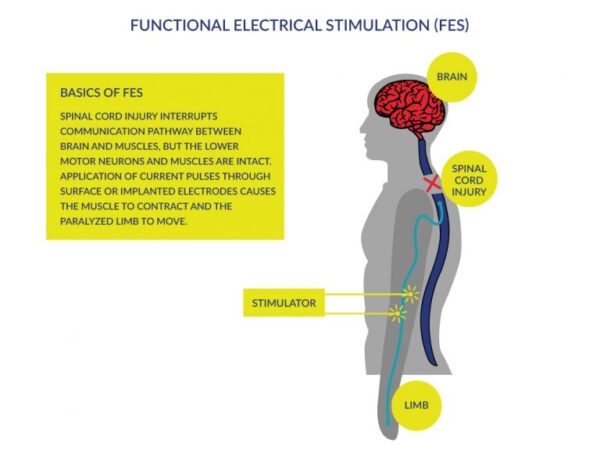Functional Electrical Stimulation (FES) and Walking
The idea of compensating for paralyzed function using ES was first tested in the 1960s when FES of the common peroneal nerve was effective in assisting foot clearance during the swing phase of walking (Liberson et al. 1961). Approaches that focus on swing phase activity are more suitable for people with less severe disabilities and adequate balance to support their stance leg during gait. There are also more complex systems that involve several channels of stimulation that support proper extension as well as foot clearance during swing (e.g., Sigmedics 2000). These are more suitable for patients who require assistance in standing as well as gait, such as those with neurologically complete SCI. FES systems such as the Parastep or ALT-2 provide stimulation of thigh extensor muscles (quadriceps, gluteal muscles) to support extension and standing, as well as stimulation of the common peroneal nerve to assist with swing phase movements. FES may also be combined with bracing to counter trunk and hip instability (Solomonow et al. 1997). FES to assist with foot clearance during swing (drop-foot) has been studied more extensively in the stroke population (e.g., Bosch et al. 2014) but they may provide some assistance for people with incomplete SCI who present with hemiparesis similar to stroke.

Figure 7. Basics of Functional Electrical Stimulation (FES)
With improvements in electronics technology, FES systems have become smaller and more practical for everyday use. In addition, some patients have opted for implanted FES systems that may be inserted without surgery. Percutaneous electrodes, which are inserted through the skin with a hypodermic needle, offer one possibility to circumvent complications with surface electrodes, as well as offering more precise delivery of stimulation and greater muscle selectivity, including access to deeper muscles like the hip flexors (Kobetic et al. 1997; Marsolais & Kobetic 1986). However, there may be complications due to infection or irritation at the site of insertion, and electrode movement or breakage (Agarwal et al. 2003). Thus, preliminary reports of the use of such innovative FES technology are promising, but further study is warranted to determine the long-term stability, efficacy, and complications of such implanted systems.
